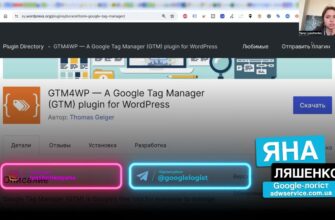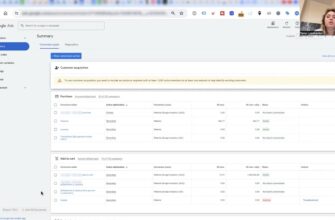- Why is it important to find the right target audience?
- How to segment the target audience for contextual advertising?
- Target audience segmentation using Mark Sherrington’s 5W method
- What (What)?
- Who (Who)?
- When (When)?
- Where?
- Why?
- How to determine the target audience in contextual advertising?
- Looking for your product or service
- Looking for how to solve their problem
- Target audience that is not currently looking for anything
- Non-target audience
- Already bought or not bought yet
- How to create a portrait of the target audience in contextual advertising?
- Use analytics systems
- Interview
- Collect data from social networks
- Consider the places that the audience attends
- Study competitors
For contextual advertising to work as effectively as possible, it is necessary to correctly identify the target audience. Unfortunately, many people underestimate the importance of this step and focus more on optimizing ads and selecting keywords rather than on the marketing component. As a result, the business owner believes that advertising does not work, and budgets are wasted.
According to the latest Marketo research, personalized ads that take into account the interests and characteristics of your target audience are 42% more effective than generic offers. And Google statistics show that with proper targeting, ad click-through rates can increase by 11% and conversions by 22%.
That’s why it’s so important to thoroughly study your target audience in contextual advertising – to understand their pains and fears, motivations and barriers that prevent them from making a purchase. This is the only way to create truly catchy ads that will attract the right people and bring maximum profit from every hryvnia invested.
How many calls and sales will I get by ordering contextual advertising from you?
I need to calculate the conversion of my website Describe
the task
in the application
Calculate potential ad revenue Google
contextual advertising calculator
Why is it important to find the right target audience?
The question “how to find the target audience for contextual advertising” is the cornerstone of a successful campaign. Without a clear understanding of whom the offer is addressed to, you risk wasting your budget by appealing to too wide and inappropriate a circle of people.
The target audience is not just abstract “men and women from 18 to 75 years old.” These are specific people with their own needs, pains and desires that the product being sold can satisfy. They have similar characteristics – age, gender, geography of residence, income level and interests. And the main task is to identify these characteristics and use them for precise targeting.
Correctly defining the target audience allows you to speak with clients in the same language, using images, triggers, pains and dreams that are understandable and close to them, choose the optimal channels and platforms for advertising, and also create the most relevant ads and landing pages that motivate to purchase .
A striking example is the company Penzeys Spices, which sells spices. After analyzing their target audience, they found out that their main customers are housewives over 35 years old who are passionate about cooking. Armed with this knowledge, Penzeys adapted all their marketing: they began advertising recipes for dishes with spices, launched a culinary blog and online school, and began sponsoring cooking shows. Sales increased by 23%.
How to segment the target audience for contextual advertising?
For advertising to be truly effective, it is not enough to simply identify your target audience. It is necessary to conduct a more in-depth analysis and divide it into segments – groups of people with similar qualities, interests and behavior patterns.
Such segmentation of the target audience for contextual advertising will allow you to customize personalized ads that will resonate with each selected group.
Target audience segmentation using Mark Sherrington’s 5W method

This approach is based on the fundamental law of marketing: “Every product has its own consumer.” The essence of the method is to use five key questions to create portraits of potential clients and divide them into separate groups with similar characteristics.
What (What)?
What exactly is a potential buyer looking for and wanting to order? What characteristics, properties and advantages are important for it? The answer to these questions helps determine the type and category of the offer, as well as highlight its key attributes and benefits that will be significant to the target audience. This will allow you to create more relevant ads and landing pages that appeal to the specific needs and desires of each segment.
For example, if a store sells children’s products, then at the What stage the marketer needs to specify the offer to a specific category and target group. For example, “construction sets for children 6–9 years old”, “LEGO for children”, “simple construction sets for a three-year-old child”, etc. The more accurately a product is described for a specific audience segment, the easier it will be to create an offer for it with relevant triggers.
Who (Who)?
Who is the ideal client for a business? What characteristics, traits and features does it have? Drawing up a thoughtful portrait of the target audience allows you to more accurately target advertising and personalize ads.
Depending on this, you can segment the audience according to the following parameters:
- Demographic (gender, age, presence of husband/wife, child, income level, type of employment, education, etc.).
- Geographical (country of residence, region and locality).
- Psychographic (values, hobbies, interests, lifestyle, character traits).
- Behavioral (decision-making model, preferred brands, price sensitivity, loyalty, habits).
The more detailed each segment is described, the better. Let’s say a store sells uniforms for medical personnel. This means that men and women from other specialties do not automatically fall into the target audience. But it makes sense to divide users of the desired profession into subsegments and create a separate ad group for each of them: uniforms for nurses, uniforms for beauty salon technicians, suits for surgeons.
When (When)?
Think about when the consumer is most likely to look for what you offer? When does he need the product or service being sold? Answering these questions will tell you how to tailor your marketing messages and when is the best time to engage with each segment.
For example, if a store sells protein bars, then the audience will be especially receptive to advertising:
- During lunch break at work;
- After training in the gym;
- On the road, traveling or for a walk.
You can even set up ads to display at specific times and days of the week, and in the message, focus on the situation in which the product is most useful.

Where?
The question “Where?” 5W audience segmentation focuses on the channels and places where potential customers search for product information, make purchasing decisions, and make purchases. Analysis of this parameter helps to select suitable platforms and formats for interaction with each audience segment.
Key points to consider:
- Online or offline? Determine where your audience prefers to search and buy: in online stores, marketplaces, social networks or traditional retail outlets.
- Devices and platforms. If your target audience is active online, find out from which devices (PC, smartphone, tablet) and in which services (websites, applications, social networks) they spend more time.
- Sources of information. Where do potential customers look for product information? In search engines, forums, blogs, reviews or opinion leaders?
- Decision-making model. Analyze the customer’s path from the first contact with the brand to making a purchase. How long does this process typically take, and what touchpoints does it pass through?
For example, you sell pet products. The target audience is modern city dwellers aged 25-40. They actively use the Internet and prefer online shopping. The audience spends a lot of time on Instagram, TikTok, YouTube, and also reads thematic Telegram channels and blogs. Reviews and recommendations from other owners are very important to them.
Why?
Why do people buy the product? What problem do they want to solve and what need do they want to fill? Understanding the underlying motivation helps you create the most compelling and compelling offers for each segment. There are 4 main types of motivation:
- Functional. Purchasing a product for its intended purpose and practical properties (for example, a drill for making repairs).
- Emotional. The desire to get pleasant sensations, impressions and emotions (chocolate to cheer up).
- Social. The desire to belong to a certain group and correspond to status (fashionable clothes, to be accepted in the company).
- Economic. The desire for financial gain and savings (discounts, bonuses, cashback).
The better you describe the motivation for each segment, the more accurately you will hit the pain points and offer killer triggers for purchase. According to a Harvard Business Review study, companies that embrace the emotional component of customer experience earn 25% more profit.
How to determine the target audience in contextual advertising?
The key to success is to correctly identify the target audience in contextual advertising. It allows you to divide potential buyers into groups based on similar characteristics, behavior and needs. This allows you to create highly personalized advertising campaigns that will hit the target and achieve high conversions.

Looking for your product or service
These people have already come a long way to realizing their needs, studying the market and comparing various offers. They are closest to making a purchasing decision and may even be familiar with the brand. Your task is to be in the right place at the right time and make an offer you can’t refuse.
The main indicator that the user is at this stage is the use of commercial (transactional) queries in the search. These are phrases that clearly signal the intention to buy, for example: “order an iPhone 13 Pro”, “pizza delivery to your home”, “connect home Internet”, etc. According to Wordstream, commercial queries convert into purchases on average 3-5 times better than informational queries.
How many calls and sales will I get by ordering contextual advertising from you?
I need to calculate the conversion of my website Describe
the task
in the application
Calculate potential ad revenue Google
contextual advertising calculator
However, it is important to understand that not all topics express commercial interest directly. Sometimes users may search for seemingly informational phrases, but imply that they are ready to buy. For example, the request “how to choose a CRM system” may mean that a person has already made a decision to implement and is now choosing the appropriate product. And the phrase “cost of laser hair removal” signals a clear transactional intent, although it does not contain the words “buy” or “order.”
Looking for how to solve their problem
The audience at the stage of searching for a solution to their problem are people who have already realized their need, but do not yet know how to satisfy it. They actively search for information, ask questions, read articles and reviews.
The goal at this stage is to intercept the user at the time of search, give him useful information and gently lead him to the idea that your product is an ideal option. Search advertising campaigns focused on informational (problematic) key queries work well for this.
For example, a person wants to get rid of procrastination and searches on Google for “how to stop putting things off until later.” This is a clear signal that he has a problem and is actively looking for a solution. Your task is to show him an ad in the spirit of “5 proven ways to overcome procrastination” and transfer him to a useful blog article. There you can talk about the problem in more detail, give valuable advice and unobtrusively mention your product (for example, a task planner or a course on time management) as one of the tools.
Target audience that is not currently looking for anything
For example, a company has released an innovative gadget or launched a unique service. Something that simply did not exist on the market before. The target audience objectively needs this, but is not even aware of it yet. And the task in this case is to awaken this need in them, create demand and desire to buy.
Or another example. You sell a cool product, but in a highly competitive niche. To stand out from other players, you need to not only win over their customers, but also attract a completely new audience. People who currently do not think about such products at all, but in the future may become buyers.
Non-target audience
According to Forrester Research, on average, 37% of advertising spend goes to irrelevant audiences. Imagine, every third hryvnia you simply throw away! Moreover, showing advertisements to the “wrong” people can even harm the brand’s image. According to a survey by Infolinks, 62% of users have a negative attitude towards irrelevant ads and find them annoying.
How can you determine who is definitely not part of your target audience? Here are some examples:
- Demographics. Let’s say you are selling expensive Swiss watches. It is unlikely that their target audience is teenagers or pensioners with low incomes. Or, for example, your product is luxury men’s cosmetics. This means that women automatically fall into the negative audience.
- Geography. If a restaurant delivers sushi only in Kyiv, then all requests from other cities are a potential drain on the budget. The same applies to local offline businesses that operate in a specific territory.
- Intention. Often, based on search queries, you can clearly separate “your” users from random ones. For example, an online agency offers website creation services. Phrases like “how to make a website yourself”, “free website builder” clearly indicate an audience that is not willing to pay.
- Specific negative keywords. Each niche has its own terms and phrases that help cut off unnecessary traffic. For example, if you sell original branded bags, then queries containing the words “replica”, “copy”, “cheap” are clearly entered by a non-target client.
Already bought or not bought yet
One of the most valuable audiences for any business is people who have already interacted with a website or product. They searched for something, clicked, added to cart, maybe even made a purchase. Unlike “cold” users, these guys are already familiar with the brand to one degree or another. And your task is not to let them leave, but to convert their interest into repeat sales or completed transactions.
This is why remarketing exists – a powerful tool in contextual advertising. Essentially, it’s “stalking” your audience across the internet with personalized ads. Google research shows that remarketing campaigns can increase conversions by 70% and ROI by 300% or more. So, if you are not using this channel yet, you are missing out on a huge opportunity for growth.
Depending on user actions, two main segments for remarketing can be distinguished:
- Those who have already bought something. These people have already become your clients, they trust you and are ready to buy more. The goal is to retain them and stimulate repeat and additional sales. To do this, you can show personal recommendations based on past purchases, special offers for regular customers, announcements of new products and promotions.
- Those who have not yet purchased. These are users who showed interest, but for some reason did not follow through. Added an item to your cart but did not pay; looked at a specific service, but did not submit a request; started to fill out the form, but gave up. It is important to understand what prevented them and remove these barriers.
How to create a portrait of the target audience in contextual advertising?
To truly understand your potential customers and create offers they can’t refuse, you need to create a detailed portrait of the target audience in contextual advertising. This is, in fact, a collective image of an ideal customer, including many characteristics – from demographics and geography to personality type and values.

Use analytics systems
The main source of data is a CRM system or a customer database in any other format (spreadsheets, mailing lists, even a paper file). Immerse yourself in this data, segment it according to different parameters: age, gender, location, frequency and number of orders, average bill, preferred product categories, etc. Look for patterns, trends and typical customer profiles.
Another valuable resource is a web analytics service, such as Google Analytics. It will help to create a portrait of not only buyers, but also website visitors: how they find a web resource, what keywords they use, what pages they look at and at what stage of the funnel they “fall off.”
It’s worth mentioning separately about the “look-alike” function in the Google Ads advertising account. You upload data about your real clients there (for example, from a CRM), and the algorithms find people with the most similar profile and behavior. This is a powerful tool for expanding the coverage and search for new customers, which allows you to save the budget and increase the conversion.
Interview
Numbers and graphs is a skeleton, but in order for the portrait of the CA to turn out to be voluminous and “alive”, you need to add real stories, opinions and emotions of customers to it. And the best way to get this priceless feedback is to interview.
Start by a survey of sales or consultants managers if you have offline sector. These people are on the front front, every day they communicate with the tsar and know her better than anyone. Ask them who usually buys goods, who comes to “look”, but leaves with nothing. What typical buyers look like, what they ask what they praise and what they criticize. Such first -hand insidies will help to make a collective image of the client.
But the main thing is, of course, an interview with the buyers themselves. Living communication will make it possible to look at the business through the client’s business, understand his pains, fears, prejudices, and what he is guided by when choosing. You can literally get into his head and get information that is not in any CRM. Unlike dry data from analytics, social networks give a lively and multifaceted cut of the Ts – its interests, hobbies, lifestyle, views, pain and desires. Everything that will help create a voluminous and catchy portrait of the buyer.
Collect data from social networks
Start by analyzing the audience on the company page on social networks. Most platforms give basic statistics on subscribers – gender, age characteristics, location and activity. But this is not enough. Cream deeper – study that people write in the comments to posts, what topics they respond, what questions they ask. This will give an invaluable understanding of their “language” and motives.

The next step is to track the mention of the brand, product or services in social networks. Use special tools that allow you to find all relevant discussions, even if you are not noted directly. Analyze the context of these references, sentiment (positive, negative, neutral) and authors. This will show how the audience really perceives and describes the brand.
A separate and very valuable source of insights – thematic communities, forums and groups in social networks. Find the sites where they discuss topics related to your niche or product. Study what they say about what questions and problems worry people, what brands and solutions advise. You will literally see a cut of consciousness of the potential tsa – its pains, fears and prejudices.
Consider the places that the audience attends
In the case of offline radiations, everything is more or less obvious. If you sell premium organic products, it makes sense to focus on people visiting farm markets, eco-stores or vegan cafes.
supply goods for fitness and a healthy lifestyle? Take a closer look at the audience of gyms, yoga studios and healthcares. Placing advertising in such places or launching a campaign, targeted by location, you are likely to get on the target with a high probability.
But today geotargeting is also relevant for online business. After all, the digital trace of a person has a binding to the place. When we are looking for something on the Internet, we go to sites and use applications-all this often has a geographical reference. And the smart algorithms of Google ADS are able to read and use it to show relevant advertising.
For example, you sell a course on financial literacy. It makes sense to show advertising to people who visit banks, are looking for information about investment and savings and use mobile applications to account for the budget. This is probably just the audience that seeks to figure out its finances and is ready to study.
Study competitors
Start by searching and collecting information. Look at the sites and at the social network of competitors, analyze their content and advertising. Who are they focusing on, what pains and desires of customers affect? What promises and offers are broadcasting? By indirect signs, you can already make an approximate portrait of their tsa.
Next – we go deeper and look at the actual interaction of the audience with competitors. We read reviews and comments on their posts, topics of discussion in communities. What they ask what people like or do not like in their products? What words describe their experience? Such first -hand feedback is a storehouse of valuable insights about real pains, barriers and triggers of a potential audience.

















